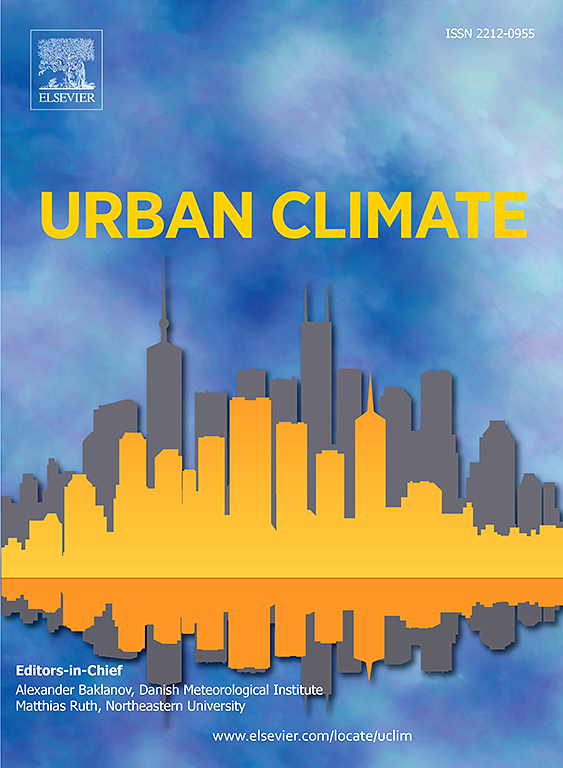脆弱的社区被抛在后面了吗?来自马达加斯加塔那那利佛绿地不平等的城市降温差异
IF 6.9
2区 工程技术
Q1 ENVIRONMENTAL SCIENCES
引用次数: 0
摘要
城市化的升级对富裕和贫困社区的城市热量都有重要贡献。社区热脆弱性通常以社会人口构成为特征,很少考虑人们不平等地暴露于绿色空间的地方以及它们与冷却差异的关系。结合地表温度,这个塔那那利佛案例研究使用绿地暴露基尼系数来绘制脆弱社区的位置,并评估其冷却效果与其他社区的差异。结果表明,近25%的社区是不平等的,其中一些网格单元的绿色空间暴露值比其他网格单元高得不成比例,增加了对城市热量的脆弱性。与其他更平等的社区相比,这些脆弱社区的冷却效果平均高出0.01°C。具体而言,脆弱社区的主要降温作用是农业用地,覆盖率增加1%,导致白天温度降低0.02-0.03°C。相比之下,同等邻里的降温效果依赖于非农业绿地,覆盖率增加1%,导致夜间温度降低0.01-0.02°C。与此同时,2017年和2022年的冷却模型确定了同等社区中存在62%和78%的绿地阈值,这估计可以降低平均0.78°C和1.24°C的夜间温度,从而使经历高温的同等社区达到更舒适的范围,无论其他因素如何。然而,在脆弱社区没有检测到阈值。城市化、拓扑条件、植被冠层、土地覆盖和日夜地表温度变化等因素影响着脆弱社区和平等社区之间的降温差异。这些降温差异也描绘了社区如何从平等发展到脆弱的轨迹。我们的研究结果强调了公平的绿地分布对城市热缓解和适应的贡献,暗示了塔那那利佛和非洲及其他地区其他城市中心边缘化社区的降温策略。本文章由计算机程序翻译,如有差异,请以英文原文为准。
Are vulnerable neighbourhoods left behind? Urban cooling disparities from greenspace inequality in Antananarivo, Madagascar
The escalation of urbanisation contributes significantly to urban heat in both affluent and impoverished neighbourhoods. Community thermal vulnerability is often characterised by socio-demographic composition, with little consideration as places where people are unequally exposed to greenspace and how they associate with cooling disparities. Combining land surface temperature, this Antananarivo case study employed greenspace exposure Gini coefficient to map the locations of vulnerable neighbourhoods and evaluate how their cooling effect differ from others. Results show that nearly 25 % neighbourhoods were unequal where values of exposure to greenspace is disproportionately higher in some of grid cells than others, raising vulnerability to urban heat. These vulnerable neighbourhoods exhibited an average 0.01 °C greater cooling effect compared to the rest of more equal neighbourhoods. Specifically, main cooling role for vulnerable neighbourhoods is agricultural land with a 1 % coverage increase leading to a 0.02–0.03 °C temperature reduction in the day. Comparatively, the cooling effect for equal neighbourhoods relies on non-agricultural greenspace with 1 % coverage increase resulting in a 0.01–0.02 °C temperature reduction at night. Meanwhile, cooling models from 2017 and 2022 identified greenspace thresholds of 62% and 78% existing in equal neighbourhoods, which estimated to reduce average 0.78 °C, 1.24 °C nighttime temperature to bring equal neighbourhoods who were experiencing the high temperature to a more comfortable range regardless of any other factors. However, there was no thresholds detected in vulnerable neighbourhoods. Cooling disparities between vulnerable and equal neighbourhoods is influenced by factors of urbanisation, topology conditions, vegetation canopy, land cover, and day-to-night land surface temperature variations. These cooling disparities also depicted the trajectory of how neighbourhoods evolve from being equal to becoming vulnerable. Our findings emphasise the contributions of equitable greenspace distributions to urban heat mitigation and adaptation, implicating cooling strategies for marginalised communities in Antananarivo and other urban centres across Africa and beyond.
求助全文
通过发布文献求助,成功后即可免费获取论文全文。
去求助
来源期刊

Urban Climate
Social Sciences-Urban Studies
CiteScore
9.70
自引率
9.40%
发文量
286
期刊介绍:
Urban Climate serves the scientific and decision making communities with the publication of research on theory, science and applications relevant to understanding urban climatic conditions and change in relation to their geography and to demographic, socioeconomic, institutional, technological and environmental dynamics and global change. Targeted towards both disciplinary and interdisciplinary audiences, this journal publishes original research papers, comprehensive review articles, book reviews, and short communications on topics including, but not limited to, the following:
Urban meteorology and climate[...]
Urban environmental pollution[...]
Adaptation to global change[...]
Urban economic and social issues[...]
Research Approaches[...]
 求助内容:
求助内容: 应助结果提醒方式:
应助结果提醒方式:


